Duke Divinity School:
The Refectory
Durham, North Carolina
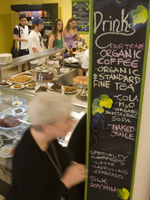 |
| Duke Divinity School's Refectory cafe has helped the larger university community discover that the divinity school cares about "green" issues. It's become a popular lunch spot for divinity school students and undergrads alike. (DUKE UNIVERSITY PHOTOGRAPHY) |
Duke Divinity School didn't have its own eating establishment until two years ago, when the school completed a $22 million addition. "We wanted to give faculty and students and staff a chance to eat together, to help build community," said Greg Duncan, associate dean for student services at the United Methodist school. As people weighed in on the facility's menu, prices, and decor, one group of students proposed a "green cafe" that would put into practice the key lesson they learned in professor Ellen Davis's class on biblical ecology and agrarianism: Eating is essentially a theological act that calls us to be ethical stewards of God's creation.
Their idea, which quickly gained favor, was to buy locally grown products, support fair trade and offer a living wage to employees, serve organic foods when possible, and recycle everything they could.
"At first we were nervous about costs and whether we'd have enough local farmers to supply the food," said Duncan, who co-chaired the dining committee. Still, as the committee explored the option, it found some strong supporters of the green cafe concept. One was Jim Wulforst, director of Duke University Dining Services. Wulforst promptly helped outfit the cafe with the necessary appliances and dug through storage for tables, dishes and silverware, which kept start-up costs down and reused materials in the process.
The Refectory opened in January 2006 and currently serves 700 people a day. The food gets rave reviews (the vegetarian chili won this year's Durham Chili Challenge) and is presented alongside tabletop signs that explain the values the cafe is trying to live out. "All the food is made from scratch, we use local ingredients and it's good for you," said Laura Hall, owner of Bon Vivant Catering, which operates the cafe. "We have the cleanest place in town — a perfect sanitation score — and we're teaching people, too."
A key challenge is keeping prices affordable for divinity students, and the cafe offers them a $6.95 lunch special that includes a half-wrap, a cup of soup, and a "dessert bite."
One of the surprise benefits of the Refectory is the enthusiasm and patronage of the larger Duke community. "It's helped undergraduates discover that the divinity school cares about these issues," Duncan said. It's also serving as a conduit that's gotten undergrads to plug into the divinity school's programming. At the school's two most popular lectures last year, "I'm sure at least 150 of the attendees were undergrads who heard about the lectures by coming to the Refectory," he said.
Others, too, have found the cafe, including bus tours that endure the campus's difficult parking for a taste of the Refectory's homemade soups and stratas. Two schools — North Carolina State and UNC Chapel Hill — have approached Hall to learn about starting green cafes, as well.
What to make of the Refectory's near-instant success? "I think it's evidence that God is involved in this," said Duncan. "Eating this way is more than just filling our stomachs with something."
Advice: "You have to be passionate about what you're doing because it's not an easy undertaking or a normal institutional process," said Hall. One example: the time the cafe's order of eggs was stolen from a local farm and they had to wait a week for the chickens to produce more. "In the conventional restaurant world you always have your supply.
In our world, you have relationships. We have a sense of loyalty to the farmers and the people we are supporting, and they have a sense of loyalty to us."
The General Theological Seminary:
Geothermal system
New York, New York
New York City's Chelsea Square is looking a little greener every day as the General Theological Seminary continues work on a new energy-efficient geothermal system. The 190-year-old Episcopal school is undertaking the largest such project in the city by replacing its oil-burning heating-cooling system with a field of wells under the sidewalks surrounding campus.
General's trustees and senior staff first considered a geothermal system four years ago when it brought in architects and engineers for an infrastructure needs assessment. "It was a difficult decision," said Maureen Burnley, executive vice president for finance and operations and manager of the geothermal project. "It was more expensive to install, but it will be significantly less expensive to operate." In the first 10 years of the system's operation, General expects to have offset all construction costs and to reduce its carbon dioxide emissions by more than 14,000 tons.
Geothermal heat pump systems use groundwater to take advantage of the earth's constant temperature. During the winter, when it's warmer underground, heat is transferred upward. During the summer, heat is transferred down.
Drilling on the 1,500-foot-deep wells started in July, and the school has been moving incrementally to the new system as each of the 20 wells is drilled. When the project is completed, all of the seminary's 260,000 square feet of buildings will be heated and cooled geothermally. While the system uses a small amount of electricity to operate, the school is considering buying wind power. If it does, all heating and cooling will be 100 percent green.
Cost savings and preservation of historic campus buildings were significant considerations, but the seminary's decision was also influenced by the Episcopal Church's concern for environmental stewardship. (The denomination's 2003 General Convention passed legislation aimed at reducing dependence on fossil fuels, and in 2006 green tags were purchased to offset the convention's power usage.) Plus, the school wants to demonstrate to future church leaders that environmentally sensitive technology is cost-effective and achievable, even in expensive urban settings.
Perhaps the most pleasant breakthrough will come next summer, when the seminary will trade the buzz of window air conditioning units for quiet, clean, geothermally cooled air — a move that will cut carbon emissions and noise pollution in one fell swoop.
Advice: Do a cost/benefit analysis in the early stages of a proposed green project, and determine the basic return on investment. "For an institution that recently upgraded its HVAC system, it might not be the right time to move to geothermal," said Burnley.
Saint Meinrad School of Theology:
Trees and more
St. Meinrad, Indiana
Thousands of new trees are growing on the grounds of Saint Meinrad Archabbey, home to Saint Meinrad School of Theology. Last year, in partnership with American Electric Power (AEP), Saint Meinrad planted more than 180 acres of hardwood trees to help recover carbon dioxide from the atmosphere and offset pollution. Last spring, with help from the U.S. Department of Agriculture's Wetlands Reserve Program, the Roman Catholic institution in southern Indiana planted trees on an additional 375 acres of crop and pasture land in order to preserve wildlife, conserve soil and boost water purity. These two projects put trees on 27 percent of the archabbey's land, most of which is already forested.
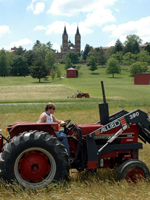 |
| With the partnership of American Electric Power and the U.S. Department of Agriculture's Wetlands Reserve Program, Saint Meinrad School of Theology has planted more than 550 acres of trees on its land in southern Indiana. (JOHN FARLESS/ST. MEINRAD SCHOOL OF THEOLOGY) |
Other green projects are taking root at Saint Meinrad, too. The main seminary building's single-pane windows in wood frames are being replaced with energy-saving Low-E glass, and the windows on the south, west, and east sides of the five-story building will use thermal pane glass to help reflect heat during the summer. When the seminary recently opted to add air conditioning to student rooms and faculty offices, they chose a 450-ton water chiller — just over half the size of the initial plan — that cuts costs and energy usage by storing water cooled at off-peak times in an already existing but empty water tower.
Used motor oil and transmission and hydraulic fluids from seminary cars are also getting a second life as fuel for the new Energy Logic Waste-Oil furnace in the archabbey's physical facilities shop and warehouse. In addition to contributions from the archabbey's vehicle fleet, more than 1,000 gallons of used motor oil have been donated by other local sources. The furnace does the double duty of recycling used motor oil — Earth911 estimates that 180 million gallons are illegally disposed of every year by people who change the oil in their cars and trucks and dump it in the garbage or down a drain — and has eliminated the need for natural gas to heat the 16,000-square-foot building.
John Wilson, a trustee of the Saint Meinrad School of Theology and treasurer/business manager for the archabbey, is one of the main advocates for the green initiatives. The projects' financial benefits were important, he said, but the primary inspiration ran even deeper. Wilson was inspired by documents from Pope John Paul II, the National Catholic Rural Life Conference and various Midwest bishops that articulated the Catholic perspective toward the environment. "I thought that the archabbey could be a beacon for environmental stewardship in our neighborhood," he said.
Advice: Be open to working with others in your community — even with those whom you might not expect. Benedictine Father Simeon Daly originally opposed the tree-planting partnership with American Electric Power. "I talked with my local legislators and called the Indiana Department of Environmental Management," Father Daly told On the Hill, the archabbey's newsletter. After those conversations and a presentation at Saint Meinrad that outlined the company's environmental stewardship efforts, Daly said, "I became convinced that AEP is making a long-term, ongoing effort to help the environment."
Associated Mennonite Biblical Seminary:
Green library
Elkhart, Indiana
Associated Mennonite Biblical Seminary had already sketched out plans for a new library four years ago when librarian Eileen Saner attended a green building open house at nearby Goshen College's Environmental Learning Center. She returned to the seminary and pitched the idea of a green library. The idea was received with care and reservations, Saner said, "but with definite interest."
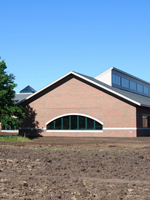 |
| The new library at Associated Mennonite Biblical Seminary features triple-pane windows, rain gardens to retain water runoff, occupancy sensors on electric lights, and a geothermal heat pump system that eliminates the building's need for natural gas. (MARY E. KLASSEN/AMBS) |
Associated Mennonite Biblical Seminary ultimately came up with four reasons to alter its old plan. A green library would allow the school to practice its Christian commitment to care for God's creation, to reduce the negative impact of the new building on the environment, to reduce the building's ongoing operational costs, and to provide leadership and encouragement for green building in the church and in the region.
"We can't reduce it to just one motivation," she said. "Clearly it's in line with the faith commitments of the seminary decision-makers. But the financial aspect is so compelling — the energy savings were significant when we were making the decision [to go green] in 2004 and are even more so now." Saner said the seminary's preliminary expectations are for the new building to pay for itself in energy savings within five years.
Associated Mennonite hired the Pennsylvania-based consulting firm 7group to guide the green design and construction process. The seminary registered its project with the U.S. Green Building Council for its "Leadership in Energy and Environmental Design" (LEED) certification, the first theological library in the U.S. and only the third academic library in the nation to do so. The LEED rating system evaluates a building project's water efficiency, energy use, materials and resources, indoor environmental air quality, sustainable sites, and innovation and design process. The seminary is aiming for a gold-level LEED rating, the second highest rating (after platinum).
Features like large, triple-pane windows designed to maximize natural light, rain gardens outside to retain water runoff, occupancy sensors on electric lights, dual-flush toilets and waterless urinals in the bathrooms, and a geothermal heat pump system that eliminates the building's need for natural gas are part of the project's sustainable construction. Finishing and furnishing the library in a sustainable way meant that the seminary reused shelving and other furnishings from the old library, purchased additional shelving used, and acquired more than 40 percent of materials from within 200 miles of the site to reduce hauling. The library's cherry trim and paneling were manufactured at the seminary itself from trees harvested in Elkhart County.
Perhaps just as impressive as the library planning and construction is the green consciousness that it's sparked at the school. Last year students initiated a communal garden that harvests produce for meals at the dining hall. Native wildflowers and prairie grasses were planted in areas that used to need mowing. The seminary has encouraged biking by adding bicycle storage, personal lockers, and a shower in the student activity center. A green housekeeping policy guides what cleansers are used and how cleaning is done. A new one-credit course in creation care — developed by a student — is being offered this fall, and there are plans to turn it into a 3-credit course down the road.
Advice: "If you're thinking about constructing a green building, make the decision early in the process," said Saner. Associated Mennonite used an integrated design process that, unlike a conventional building project, allowed the architect, engineering firm and general contractor to work together on all the project details from the beginning.
Regent College:
Radiant heat, with a park to top it off
Vancouver, British Columbia
As Regent College considered its options for a new library earlier this decade, it quickly became clear that the most cost-efficient, workable space would be under a park the school had maintained for three decades. That wasn't great news — a similar plan had been proposed and rejected in the 1980s because so many people disliked the thought of putting the library underground. The early reaction to the new plan felt like deja vu, but as Regent strained under growing space limitations, the interdenominational graduate school took the opportunity to make the inevitable project as attractive —and as green — as possible.
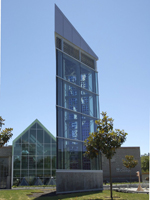 |
| (Above and below) The new underground library at Regent College is heated and cooled by a radiant system. Air is exhausted from the 30,000- square-foot library through a 40-foot-high wind tower on the roof, requiring only infrequent use of electric fans. (KEN MCALLISTER/REGENT COLLEGE) |
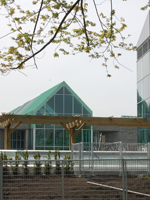 |
Regent decision-makers considered using solar panels to generate power for the building but found the cost prohibitive. Instead, the new library, which opened in January, is heated and cooled by a radiant system that makes the most of the underground location by using natural pressure to push fresh air through the library by way of floor diffusers. Air is exhausted through a 40-foot high aerodynamic wind tower on the roof of the library.
"We wanted to get away from spending money on electricity for air-handling units," said Teck-Ngee Ch'ng, vice president for administration and project manager. Now the school pays to ventilate the new 30,000-square-foot library only infrequently, when the electrically powered back-up fans are needed.
Before construction started, faculty, staff, students, and local landscapers spent days in the park digging out trees, bushes, and flowers to be transplanted in other gardens around Vancouver. The redesigned Regent Park includes grass, flowers, trees, benches and the wind tower, which sits in the middle of the park.
And in the end, the school found a way to incorporate solar power, too. Toronto artist Sarah Hall created "In Partnership with the Sun," a glass art installation integrated in the wind tower. The first of its kind in North America, the installation combines glass art with solar cells that collect enough energy to illuminate the tower at night. "Stained glass has a thousand-year history," she said. "Using solar energy is one way of bringing new technology to an art form that most people consider traditional and unchanging."
Advice: If at first you don't succeed, try, try again. By revisiting the first-rejected solar power idea, Regent was able to commission a groundbreaking work of art. And as Regent's president, Rod Wilson, described in Regent's alumni magazine, a change in perspective helped shift sentiments about the underground library. When the building committee announced its decision about going underground, one board member responded with, "It will be like the catacombs!"
American College and University Presidents Climate Commitment
More than 300 college and university presidents (some including theological schools and divinity schools) have become charter signatories of the American College and University Presidents Climate Commitment, a pledge to show leadership in eliminating emissions that contribute to global warming and in educating students to work toward "climate neutrality."
By signing on to the climate commitment, participants recognize the challenges associated with efforts to address climate change but also affirm medium- and long-range benefits as well, including achieving energy independence.
Signatories promise to pursue practical steps, including:
-
Completing a campus emissions inventory.
-
Setting a target date and interim milestones for becoming climate neutral.
-
Taking immediate steps to reduce greenhouse gas emissions by choosing from a list of short-term actions.
-
Integrating sustainability into the curriculum and making it part of the educational experience.
-
Making the action plan, inventory and progress reports publicly available.
Signatories from universities that include accredited theological schools include
-
David Black of Eastern University (which includes Palmer Theological Seminary).
-
Richard H. Brodhead of Duke University.
-
Joel Cunningham of Sewanee: The University of the South. Dietrich Reinhart of St. John's University (Collegeville, Minnesota).
More information: www.presidentsclimatecommitment.org